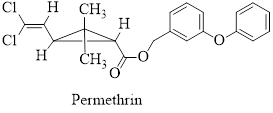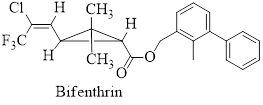
Concept explainers
Interpretation: The correct sterochemical descriptor for the
Concept introduction:
Alkenes are one of the important types of hydrocarbon which have at least one carbon-carbon double bond (
E-Z designators are used as like cis-trans terminology for non-similar groups attached alkenes.
In E-Z designations, the groups attached to vinylic positions are checked by their priority on the basis of higher molecular weight. If the higher priority groups are on the same sides, then the configuration is designated as Z. If the higher priority groups are on the opposite sides, then the configuration is designated as E.
Permethrin and bifenthrin are the synthetic pyretherenoids now in common use in household and agricultural products.
Their structure is given below,


Want to see the full answer?
Check out a sample textbook solution
Chapter 17 Solutions
Organic Chemistry
- Briefly indicate, with examples, the use of inorganic heterocycles in the synthesis of the corresponding polymers.arrow_forward1) Show how to use solid phase techniques to synthesize Ala-Val-Phe. You may use any amino acids (including protected amino acids) and any inorganic reagents that you wish in carrying out your synthesis. You don't need to show any mechanisms for this synthesis. You can maximize your chances of partial credit by showing key intermediates. (12 points)arrow_forward5) AZT is a drug that is used to treat HIV/AIDS. When cells take up AZT, they convert it to AZT- triphosphate. AZT-triphosphate prevents the virus from synthesizing new DNA from its RNA code. a. Write a 1-2 sentence explanation describing how AZT-triphosphate prevents DNA synthesis. (4 points) HO NH 'N' O © © N=N=N AZT b. Circle the location on AZT where the triphosphate group is appended (2 points)arrow_forward
- 1) What is epimerization? A) It involves changing the configuration of a carbon B) It involves oxidation of an aldose. C) It involves lengthening the chain of an aldose. D) It involves reduction of an aldose. E) none of the above 2) Which of the following monomer: polymer pairings is mismatched? a. Amino acids: proteins b. Amino acids: peptides c. Monosaccharides: polysaccharides d. Nucleotides: DNA e. They are all correctly matched 3) How do the a and ẞ anomer of a sugar differ? a. By the configuration of the acetal carbon in the ring form b. c. By whether a ketone or aldehyde is present in the straight chained form By the presence/absence of a 2' OH d. By whether the OH on the last chiral center is pointed right or left in the Fischer projection of the straight chained form 4) A salt bridge can occur as part of the apply) a. Primary structure b. Secondary structure of a protein (select all that c. Tertiary structure d. Quaternary structuré 5) True or false: A protein that has been…arrow_forward11C.7 Before solving the problem please also give a brief explanation of the concept or associated equation(s) and variables.arrow_forwardDraw the mechanism in the paperarrow_forward
- 7E.3 Before solving the problem please also give a brief explanation of the concept or associated equation(s) and variables.arrow_forward11c.5 Before solving the problem please also give a brief explanation of the concept or associated equation(s) and variables.arrow_forward(12 pts. - 3 pts. each part) For each of the following complexes, give the charge of the metal center and determine if the complex obeys the 18 Electron Rule. Show work or justification (a) Ni(PPh3)4 (b) (n-C6H6)Cr(CO)3 (c) (C2H4)2(n³-C3H5)W(CH3)2 (d) (cod)Rh(μ2-Cl)2Rh(cod) (No Rh-Rh bonds)arrow_forward
 Organic ChemistryChemistryISBN:9781305580350Author:William H. Brown, Brent L. Iverson, Eric Anslyn, Christopher S. FootePublisher:Cengage Learning
Organic ChemistryChemistryISBN:9781305580350Author:William H. Brown, Brent L. Iverson, Eric Anslyn, Christopher S. FootePublisher:Cengage Learning Chemistry for Today: General, Organic, and Bioche...ChemistryISBN:9781305960060Author:Spencer L. Seager, Michael R. Slabaugh, Maren S. HansenPublisher:Cengage Learning
Chemistry for Today: General, Organic, and Bioche...ChemistryISBN:9781305960060Author:Spencer L. Seager, Michael R. Slabaugh, Maren S. HansenPublisher:Cengage Learning Introduction to General, Organic and BiochemistryChemistryISBN:9781285869759Author:Frederick A. Bettelheim, William H. Brown, Mary K. Campbell, Shawn O. Farrell, Omar TorresPublisher:Cengage Learning
Introduction to General, Organic and BiochemistryChemistryISBN:9781285869759Author:Frederick A. Bettelheim, William H. Brown, Mary K. Campbell, Shawn O. Farrell, Omar TorresPublisher:Cengage Learning- Chemistry: Matter and ChangeChemistryISBN:9780078746376Author:Dinah Zike, Laurel Dingrando, Nicholas Hainen, Cheryl WistromPublisher:Glencoe/McGraw-Hill School Pub Co
 Chemistry: The Molecular ScienceChemistryISBN:9781285199047Author:John W. Moore, Conrad L. StanitskiPublisher:Cengage Learning
Chemistry: The Molecular ScienceChemistryISBN:9781285199047Author:John W. Moore, Conrad L. StanitskiPublisher:Cengage Learning




